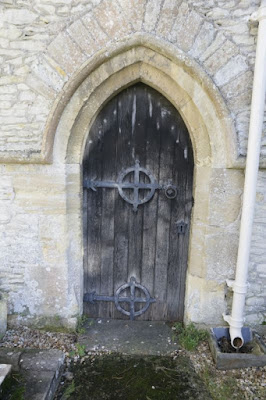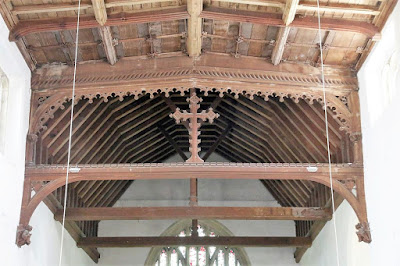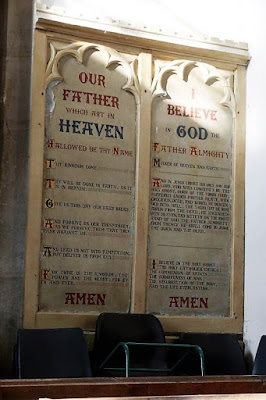This week I start the first of a series of churches from an area that was once part of Wessex, this is where King Alfred ruled and conquered the Danes. It later became part of Berkshire before ending up in Oxfordshire. Older people from the area like me still retain the broad Berkshire accent. Childrey is just outside Wantage and no doubt well known to Alfred the great as he was know. Many of the churches we will visit here date back to his time. The village dates back to AD 940 and is mentioned in the Domesday Book. Some history on the church
"The Church of England parish church of Saint Mary the Virgin was originally late Norman, built either late in the 12th century or early in the 13th, but the only surviving original features are the south doorway and the font. The chancel was rebuilt late in the 13th century. The north and south transepts were added in the 14th century, the Perpendicular Gothic west tower in the 15th and the south porch in the 16th century. One window and a tomb recess are surviving original Decorated Gothic features of one of the transepts, but both transepts now have Perpendicular windows that were inserted later.
The tomb recess in the north transept contains a fine effigy of a knight. The south transept is the larger of the two and is the family Fettiplace chapel. St Mary's is notable for its numerous monumental brasses, including one to William Fynderne (died 1444) and his wife which at 52 inches (1.3 m) long is the largest in old Berkshire. The church is a Grade I listed building.
The west tower has a ring of eight bells. Until the 21st century it was a ring of six. Ellis I Knight of Reading, Berkshire cast the tenor bell in 1632 and the fourth and fifth bells in 1639. Pack and Chapman of the Whitechapel Bell Foundry cast the second bell in 1770. George Mears & Co of the same foundry cast the treble bell in 1865, and Mears and Stainbank of Whitechapel recast the third bell in 1907. Then in 2005 the 1865 treble bell was removed and the Whitechapel foundry cast a new treble, second and third bells to increase the ring to eight.
St Mary's parish is part of the Ridgeway Benefice, along with the parishes of Kingston Lisle, Letcombe Bassett, Letcombe Regis, Sparsholt and West Challow."
This is rather a long blog so coffee and cake are advised.
My first view of the church from the wall, my first reaction was it is old. There are two paths this one to the right takes you to the Priest door in the chancel
The churchyard either side holds the older graves
The priest door looked very sturdy with impressive hinges
The bell tower which has a ring of 8 bells, the oldest cast in 1632, the lightest bells weigh in at 3cwt and the heaviest one comes in at 12cwt
On the wall is a clock that dates from 1761

The West face of the tower with double door at the base
Above the North side of the church

The east end which is the only angle I could get a photo of it from. The door I mentioned previously
Looking East towards the chantry chapel
The entrance door in the porch, you can see the 12century Norman doorway
The nave looking towards the rood screen which has a rood cross
The rood screen which was restored in the early in the 20th century
The chancel with altar and East window

The altar and the East window (Chancel)
Above the altar showing the table
Left the sedilia with to the left of it the piscina
Over in the corner here is an Easter Sepulchre
On the floor you can see some brasses. This one is a Priest dated around 1480
This slab has two brasses , the right one is William Walrond and his wife Elizabeth dating to 1480. On the left is the Roos brass dating to 1529
The choir stalls on the North side
and the ones on the South side
Looking back down to the West end of the church where you can see the organ

Here we see the South Transept which was the Chantry chapel. It has gained in recent years a kitchen and toilet which is over to the right discreetly hidden behind the door
In the chapel here you can see this First World War Grave Cross. It belongs to Major Stuart Hamilton Rickman who was killed in action in August 1914. IT is a bit of a mystery as to why it says Captain but thought the Germans did not realise he was a Major, it is also unknown as to the state of his remains when he was buried by the Germans

The altar in the chapel and Major Rickmans cross. Left of that is a piscinia and shelf
The North transept which was built in 1325 in Honour of the Blessed Virgin Mary. Below the window is an effigy of the 14th century
It is unknown who it represents but could be the W.N referred to in the window above
The stained glass in the North Transept window. The glass dates to the 14th century. The glass on the left the Virgin Mary ascending into Heaven supported by angels
The all show various scenes from the life of Christ
This one I think is the nativity
the top lights show the Virgin Mary enthroned flanked by angels
There are a lot of memorial around the church to see
some the words are there but hard to read. Some are in Latin
Memorial to James Brewer with a fair amount of his history
This one is the Beaver family Memorial, another in Latin
Above the Royal Coat of Arms with George II initials on the top
Right the Roll of Honour of the members of the Old Berkshire Hunt who were killed in the First World War

This is the Roll of Honour to the fallen of World War one & Two who belonged to the Village of Childrey
William Shippery with coat of arms at the base
Couple of Laurence memorials
who were related to the Shippery's
two plaques at the back of the church, one with verse on it from Exodus and the Our farther
Over the top of the arch at the back of the church you can see bequest plaques, the oldest is 1441
One of the nave windows with a coat of arms on it

There are a few nice stained glass windows around the church
In the North transept you can see the stairs that would have taken you to the rood loft, just inside you can see a squint

The church organ in the arch that has the bequests around it.
Right the pulpit
and the view of the nave you see from it
This was the item that really excites me, it is the church font and one of only thirty lead ones in the country. This 12 century Norman font has Abbots around the outside and is probably the oldest of it's type. There are others in the area and I have seen most of them. There is also another not far from this church as well
I took the lid off so you could get a glimpse inside
Enough of the inside I could spend ages there. Near the South transept is this part of the churchyard
The far side of which is covered in snowdrops
all growing around the gravestones
Go around the North side of the church and you see this large part of the churchyard
Above the War Grave of CPL R.A.Bennett
Left the new churchyard extension
Looking over to the newer graves
Snowdrops fill empty spaces
An old headstone beside the wall, I think it has been placed here
A last look at the snowdrops that cover the churchyard
I will leave you this week with a view of these beautiful floral displays which were being made while I was taking photos of the church.
My thanks to the lady who was making them and telling me about the church
Till Next time I wish you all a peaceful weekend








































































